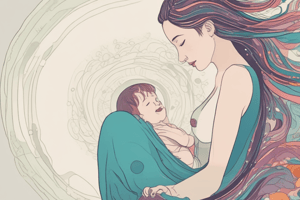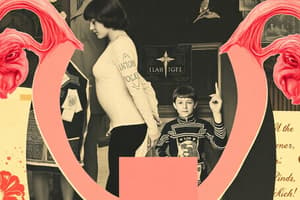Podcast
Questions and Answers
A breastfeeding mother can expect ovulation to return approximately how long after delivery, assuming exclusive breastfeeding?
A breastfeeding mother can expect ovulation to return approximately how long after delivery, assuming exclusive breastfeeding?
- 3-4 months.
- 6 months. (correct)
- 6-8 weeks.
- Immediately after cessation of lochia.
Which contraceptive method is explicitly stated as an option for postpartum contraception?
Which contraceptive method is explicitly stated as an option for postpartum contraception?
- Progesterone-only pills. (correct)
- Estrogen-based birth control pills.
- Barrier methods.
- Combined oral contraceptives.
If a non-breastfeeding mother wants to know when she can expect her menstrual cycle to return postpartum, what is the typical timeframe?
If a non-breastfeeding mother wants to know when she can expect her menstrual cycle to return postpartum, what is the typical timeframe?
- 6-8 weeks. (correct)
- 3-4 months.
- 6 months.
- Immediately, within the first two weeks.
What period of abstinence is required after a Cesarean section (CS)?
What period of abstinence is required after a Cesarean section (CS)?
Which of the following vaccines is considered teratogenic and should be avoided during pregnancy?
Which of the following vaccines is considered teratogenic and should be avoided during pregnancy?
A pregnant woman is prescribed a medication for acne. Which of the following medications would be most concerning due to its teratogenic effects?
A pregnant woman is prescribed a medication for acne. Which of the following medications would be most concerning due to its teratogenic effects?
Which common medication used to treat acne is also a known teratogen and must be avoided during pregnancy?
Which common medication used to treat acne is also a known teratogen and must be avoided during pregnancy?
A woman with a history of bipolar disorder is planning a pregnancy. Which of her medications would raise the most concern due to teratogenic effects?
A woman with a history of bipolar disorder is planning a pregnancy. Which of her medications would raise the most concern due to teratogenic effects?
Which of the following medications is listed as a teratogenic drug that could pose a risk to a developing fetus?
Which of the following medications is listed as a teratogenic drug that could pose a risk to a developing fetus?
Which of the following infections is NOT explicitly listed under TORCH infections but is considered in the 'others' category?
Which of the following infections is NOT explicitly listed under TORCH infections but is considered in the 'others' category?
Cytomegalovirus (CMV) infection in a fetus is most likely to result in which of the following complications?
Cytomegalovirus (CMV) infection in a fetus is most likely to result in which of the following complications?
What is the primary mode of transmission for toxoplasmosis, relevant to pregnant women?
What is the primary mode of transmission for toxoplasmosis, relevant to pregnant women?
Which of the following fetal effects is a recognized manifestation of congenital toxoplasmosis?
Which of the following fetal effects is a recognized manifestation of congenital toxoplasmosis?
Which of the following is NOT a typical manifestation of toxoplasmosis?
Which of the following is NOT a typical manifestation of toxoplasmosis?
What are the potential CNS signs observed in newborns with congenital toxoplasmosis?
What are the potential CNS signs observed in newborns with congenital toxoplasmosis?
A pregnant woman is diagnosed with toxoplasmosis. Which of the following fetal complications is LEAST likely to be associated with this infection?
A pregnant woman is diagnosed with toxoplasmosis. Which of the following fetal complications is LEAST likely to be associated with this infection?
Which of the following statements accurately links a TORCH infection with its potential fetal outcome?
Which of the following statements accurately links a TORCH infection with its potential fetal outcome?
How is toxoplasmosis commonly transmitted to humans?
How is toxoplasmosis commonly transmitted to humans?
A patient who is trying to conceive asks about the risk of contracting toxoplasmosis. Which recommendation is most appropriate for preventing toxoplasmosis?
A patient who is trying to conceive asks about the risk of contracting toxoplasmosis. Which recommendation is most appropriate for preventing toxoplasmosis?
Which of the following CNS signs is most indicative of congenital toxoplasmosis in a newborn?
Which of the following CNS signs is most indicative of congenital toxoplasmosis in a newborn?
Flashcards
Return of Ovulation
Return of Ovulation
6 months for breastfeeding mothers, 6-8 weeks for non-breastfeeding mothers.
Return of Menstruation
Return of Menstruation
3-4 months for breastfeeding mothers, 6-8 weeks for non-breastfeeding mothers.
Contraception - Postpartum
Contraception - Postpartum
Using pills for contraception decreases milk production as estrogen levels are reduced, non-breastfeeding mothers can use pills for contraception.
Postpartum Abstinence
Postpartum Abstinence
Signup and view all the flashcards
Teratogenic Vaccines
Teratogenic Vaccines
Signup and view all the flashcards
Teratogenic Drugs
Teratogenic Drugs
Signup and view all the flashcards
Teratogenic Drugs
Teratogenic Drugs
Signup and view all the flashcards
TORCH Infections
TORCH Infections
Signup and view all the flashcards
Toxoplasmosis Cause
Toxoplasmosis Cause
Signup and view all the flashcards
Toxoplasmosis Transmission
Toxoplasmosis Transmission
Signup and view all the flashcards
Toxoplasmosis Manifestations
Toxoplasmosis Manifestations
Signup and view all the flashcards
Study Notes
- Schedule of return to the pre-pregnancy state depends on whether the mother is breastfeeding or not
Onset after pregnancy
- Ovulation occurs at 6 months for breastfeeding mothers and 6-8 weeks for non-breastfeeding mothers
- Menstruation occurs at 3-4 months for breastfeeding mothers and 6-8 weeks for non-breastfeeding mothers
- Contraception through the use of no-pills decreases milk production in breastfeeding mothers, pills are used in non-breastfeeding mothers
- Abstinence lasts for 3-4 weeks for breastfeeding mothers and even post CS (cesarean section) for non-breastfeeding mothers which involves cervical and vaginal infection
Teratogenic Vaccines
- MMR
- HPV
- Polio
Teratogenic Drugs
- Warfarin
- Valproic acid
- Ace inhibitors
- Iodides
- Lithium
- Rogaine (hair grower)
- Thalidomide - anti emetic
- Tetracycline
- Steroids, streptomycin, statin
- Isotretinoin (for acne)
- OHA - oral hypoglycemic agents
TORCH Infections
- Includes Toxoplasmosis and others like HIV, Hepatitis, Syphilis, Rubella, Cytomegalovirus, and Herpes
- Cytomegalovirus causes neurological challenges
- Herpes causes active lesions
Toxoplasmosis
- Caused by parasite/protozoa (protozoan toxoplasma gondii)
- Transmitted through ingestion of infected, not well-cooked meat of animals
- Also transmitted from droppings of animals, specifically cat feces
- Maternal manifestations include repeated abortion
- Fetal effects consists of fetal hydrocephaly, chorioretinitis, cerebral calcification
- CNS signs include microcephaly, seizures, and severe mental retardation
Studying That Suits You
Use AI to generate personalized quizzes and flashcards to suit your learning preferences.




